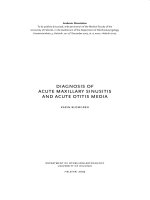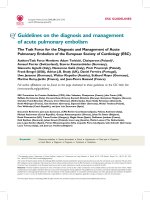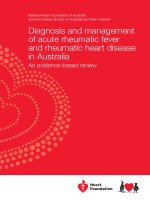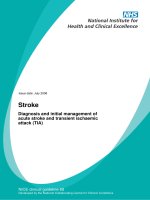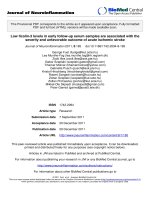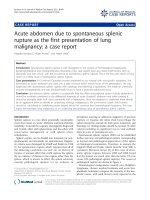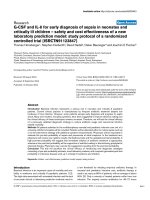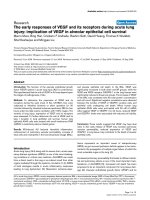cope early diagnosis of acute abdomen
Bạn đang xem bản rút gọn của tài liệu. Xem và tải ngay bản đầy đủ của tài liệu tại đây (3.45 MB, 340 trang )
Cope’s Early Diagnosis of the Acute Abdomen
Cope’s Early
Diagnosis of the
Acute Abdomen
TWENTY-SECOND EDITION
Revised by
WILLIAM SILEN, MD
Johnson & Johnson Professor of Surgery, Emeritus
Harvard Medical School
1
2010
3
Oxford University Press, Inc., publishes works that further
Oxford University’s objective of excellence
in research, scholarship, and education.
Oxford New York
Auckland Cape Town Dar es Salaam Hong Kong Karachi
Kuala Lumpur Madrid Melbourne Mexico City Nairobi
New Delhi Shanghai Taipei Toronto
With offices in
Argentina Austria Brazil Chile Czech Republic France Greece
Guatemala Hungary Italy Japan Poland Portugal Singapore
South Korea Switzerland Thailand Turkey Ukraine Vietnam
Copyright © 1957, 1963, 1968, 1972 by Oxford University Press, Inc.
Copyright © 1979, 1983, 1987, 1991, 1996, 2000, 2005, 2010 by P. A. L. Grace
First edition 1921
Twenty-second edition 2010
Published by Oxford University Press, Inc.,
198 Madison Avenue, New York, New York 10016
www.oup.com
Oxford is a registered trademark of Oxford University Press
All rights reserved. No part of this publication may be reproduced,
stored in a retrieval system, or transmitted, in any form or by any means,
electronic, mechanical, photocopying, recording, or otherwise,
without the prior permission of Oxford University Press.
Library of Congress Cataloging-in-Publication Data
Silen, William, 1927Cope’s early diagnosis of the acute abdomen. — 22nd ed. / revised by William Silen.
p. ; cm.
Includes index.
ISBN 978–0–19–973045–2 (pbk. : alk. paper) 1. Acute abdomen—Diagnosis.
I. Cope, Zachary, 1881–1974. II. Title. III. Title: Early diagnosis of the acute abdomen.
[DNLM: 1. Abdomen, Acute—diagnosis. 2. Digestive System Diseases—diagnosis.
WI 900 S582c 2010]
RD540.S495 2010
617.5’5075—dc22
2009013093
Oxford University Press makes no representation, express or implied, that the drug dosages in
this book are correct. Readers must therefore always check the product information and clinical
procedures with the most up-to-date published product information and data sheets provided by
the manufacturers and the most recent codes of conduct and safety regulations. The authors and the
publishers do not accept responsibility or legal liability for any errors in the text or for the misuse or
misapplication of material in this work.
9 8 7 6 5 4 3 2 1
Printed in the United States of America
on acid-free paper
Preface
Over 40 years ago, I was asked by a publisher to write a treatise on acute
abdominal pain, but after serious consideration, I declined because it
seemed impossible to improve on what Cope had already accomplished.
In 1967, when I was given the opportunity to revise and update Cope’s
book, it seemed to me that my responsibility in accepting the assignment
was to preserve the basic structure that has made Early Diagnosis of
the Acute Abdomen a classic for so long, at the same time bringing the
text up to date in light of recent advances and of my own experience.
This burden was lightened by the remarkable agreement I found in most
areas between my experiences and those of the original author.
I have made every attempt to follow Cope’s aim of including only
those dicta that have been repeatedly confirmed by personal experience
and observation. In keeping with this I have not added a bibliography.
The book’s major emphasis continues to be on clinical rather than laboratory diagnosis. There is little doubt that improved methods of resuscitation and a better understanding of surgical physiology have had a
great impact in improving the survival of patients with acute abdominal
disease, but a detailed consideration of these topics would entail the
writing of another book.
Recent years have brought a proliferation of both invasive and noninvasive laboratory and radiological tests, the likes of which undoubtedly
would have been a great surprise to Sir Zachary Cope. With these tests
vi
PREFACE
has come the unfounded belief that a number or a laboratory report
is somehow more reliable than the clinical history or physical findings.
The consequence has been an ever-increasing reliance on expensive
and sometimes dangerous laboratory examinations. This trend is partly
responsible for increasing the cost of medical care, and perhaps for some
morbidity and even mortality. The more pernicious outcome, however, is
the continuing atrophy of the clinical skills of history taking and physical
examination. The vicious cycle of more tests and X-rays, together with
less history and physical examination, has been accentuated even more
in the past few years by managed care, whose administrators insist on
our seeing more patients in less and less time.
Even today, however, it remains true that the vast majority of diagnoses of patients with acute abdominal pain are still made on the basis of a
careful history and physical examination. The major delays in diagnosis
today are those imposed by the failure to recognize the presence of a
significant intra-abdominal process and by the need that some feel to
obtain special complicated tests and X-ray examinations.
Reviewers of recent editions of this book have criticized the omission
of these new tests in favor of continued emphasis on the clinical aspects
of acute abdominal pain. In response, I have expanded a chapter that
attempts to guide the reader in selecting appropriate tests rather than
employing every conceivable investigation that comes to mind. I have
also added a short section describing personal observations of serious
errors made because the responsible physician (surgeon) did not fully
appreciate or understand the pitfalls of some radiological examinations.
I am more convinced than ever that overreliance on these new and
costly tests at the expense of a careful clinical evaluation will diminish
rather than improve the quality of care of patients with acute abdominal
pain. For this reason, I shall continue to emphasize the clinical pointers
that were found to be so useful by Cope and whose value has been reaffirmed by my own experience.
Sir Zachary Cope set out to write the first edition because he encountered so many cases where inordinate delay in clinical diagnosis led to
a disastrous outcome that might have been averted by earlier detection
of the true state of affairs. I am told that the publisher accepted the
manuscript for the first edition after commenting that it contained little
PREFACE
vii
that was terribly new. I suspect that these two conditions pertain today
as much as they did in 1921.
I am deeply indebted to Mr. William J. Lamsback of the Oxford
University Press, who made it possible for me to accept the challenge of
revising this book. I am particularly grateful to Ms. Nancy Kaufman for
her superb assistance in preparing the manuscript.
I am especially grateful to Dr. Vassilios Raptopoulos, director of Body
CT in the Department of Radiology at the Beth Israel Hospital, Boston,
who has provided the illustrations of the various imaging techniques. He
has been enormously helpful in placing into perspective the appropriate
indications for the large menu of imaging techniques. It has been a joy
to work with him.
Finally, I should like to pay special tribute to all who have taught me
about acute abdominal pain, including my teachers, my pupils, and particularly my patients.
Boston
2009
W. S.
This page intentionally left blank
Extract from the preface to
the first edition
All who have had much experience of the group of cases known generally as the acute abdomen will probably agree that in that condition early
diagnosis is exceptional. There are still many who do not appreciate to
the full the significance of the earlier and less flagrant symptoms of acute
abdominal disease, who regard an increased frequency of the pulse and
rigidity of the overlying abdominal muscles as necessary accompaniments of the early stage of appendicitis, or find it hard to believe that a
patient with a non-distended abdomen and normal pulse and temperature can be the victim of a perforated gastric ulcer.
It would appear, therefore, that there is room for a small book dealing
solely with the early diagnosis of such cases, for there is little need to
labour the truism that earlier diagnosis means better prognosis. Though
the present attempt to supply the deficiency may be inadequate, the
author has at least endeavoured to assist the reader to attain a correct
judgment in the evaluation of the various puzzling symptoms present in
urgent abdominal disease.
Few references are inserted and no bibliography is appended; for
whilst the writer readily acknowledges the great debt which he owes to
the teaching of such leaders as Murphy, Moynihan, Rutherford Morison,
Maylard, and many others, it has been his aim to put down nothing
which has not been frequently confirmed and demonstrated in his own
experience.
x
PREFACE TO FIRST EDITION EXTRACT
At the same time he has introduced many diagnostic points which he
believes have either never previously been recorded or to which insufficient attention is usually paid. In the former category may be mentioned
the localizing diagnostic value of phrenic shoulder pain, the obturator test, and the test for differentiating between pain of thoracic and
abdominal origin; whilst in the latter the area of hyperaesthesia caused
by a distended inflamed appendix, the pathognomonic axillary area of
liver resonance in cases of perforated ulcer, the psoas-extension test, and
the confusing significance of testicular pain, serve as examples.
London
June 1921
ZACHARY COPE
Contents
Plates, xiii
1. Principles of diagnosis in acute abdominal disease, 3
2. Method of diagnosis: the history, 18
3. Method of diagnosis: the examination of the patient, 28
4. Method of diagnosis: the grouping of symptoms and signs, 41
5. Laboratory and radiological tests, 54
6. Appendicitis, 67
7. The differential diagnosis of appendicitis, 84
8. Diverticulitis of the colon, 105
9. Perforation of a gastric or duodenal ulcer, 108
10. Acute pancreatitis, 122
11. Cholecystitis and other causes of acute pain in the right upper
quadrant of the abdomen, 131
12. Acute abdominal lesions arising in the left hypochondrium, 141
13. The colics, 145
14. Acute intestinal obstruction, 153
15. Intussusception and other causes of obstruction, 178
xi
xii
CONTENTS
16. The early diagnosis of strangulated and obstructed hernias, 190
17. Acute abdominal symptoms due to vascular lesions, 197
18. Acute abdominal symptoms in women, 208
19. Early ectopic gestation, 217
20. Acute abdominal disease with genitourinary symptoms, 228
21. The diagnosis of acute peritonitis, 233
22. The early diagnosis of abdominal injuries, 241
23. The postoperative abdomen, 252
24. The acute abdomen in the tropics, 261
25. Diseases that may simulate the acute abdomen, 271
26. Acute abdominal pain in the immunocompromised patient, 283
27. Abdominal catastrophes when sensation is impaired, 287
Index, 289
Plates
1.
Parietal muscles of the abdomen
RADIOGRAPHS
2.
Perforated appendicitis with peritonitis in a person with a classical fecalith
3A,B.
Ultrasonic and CT findings in acute appendicitis
4A,B. Barium enema and CT findings in acute diverticulitis
5A,B.
Plain film and CT in perforated ulcer
6A.
CT scan of subphrenic abscess
6B.
CT scan of acute necrotizing pancreatitis
7A,B.
Sonograms showing cholelithiosis and cholecystitis
8A.
Normal biliary scintigram
8B.
CT showing acute cholecystitis
9A.
Plain film in gallstone ileus
9B.
Plain film in obstruction of the colon by carcinoma of the
sigmoid
xiii
xiv
PLATES
10A,B. Supine and erect plain films showing ileal obstruction caused
by an inguinal hernia
11A,B. Plain film and barium enema of sigmoid volvulus
12A,B. Plain film and barium enema of cecal volvulus
13A.
Plain radiograph showing toxic dilatation of the colon
13B.
Typical barium enema in ileocecal intussusception
14A,B. CT scans in intestinal ischemia
15A.
CT of ruptured abdominal aortic aneurysm
15B.
Transabdominal sonogram of a tubo-ovarian abscess
16A.
CT showing laceration of the liver
16B.
CT showing splenic rupture
There is surely no greater wisdom than well
to time the beginning and onsets of things.
Bacon, “On Delay”
This page intentionally left blank
Cope’s Early Diagnosis of the Acute Abdomen
This page intentionally left blank
1. Principles of diagnosis in acute
abdominal disease
Before entering into the detailed consideration of the various forms of
acute abdominal pain, it is well to lay down certain principles that form
the basis of all successful diagnosis in urgent abdominal disease.
Necessity of making a diagnosis
The first principle is that of the necessity of making a serious and thorough attempt at diagnosis, usually predominantly by means of history
and physical examination.
Abdominal pain is one of the most common conditions that calls for
prompt diagnosis and treatment. Usually, though by no means always,
other symptoms accompany the pain, but in most cases of acute abdominal disease, pain is the main symptom and complaint. The very terms
“acute abdomen” and “abdominal emergency,” which are constantly
applied to such cases, signify the need for prompt diagnosis and early
treatment, not necessarily always surgical. The term acute abdomen
should never be equated with the invariable need for operation. In some
instances the urgent need for operation may be so obvious that the need
for transference of the patient to the care of a surgeon is clear. In other
cases, the observer may, if in doubt, think it wise to discuss the problem
3
4
PRINCIPLES OF DIAGNOSIS IN ACUTE ABDOMINAL DISEASE
with a fellow practitioner before deciding on any course of action. There
are, however, occasions when, with somewhat indefinite symptoms, there
is justification to wait for the development of clearer indications to see
whether the condition will not improve spontaneously and to temporize
as long as the patient is carefully observed at frequent intervals. Though
in some cases it is impossible to be certain of the diagnosis, it is a good
habit to come to a decision in each case; it will be found that after a short
time, the percentage of correct diagnoses will increase rapidly.
That there is much room for improvement in this direction cannot be
gainsaid. Operating surgeons are not free from blame in this matter, for
the ease and comparative safety of operating and the ready availability
of computed tomography (CT) and ultrasound examinations occasionally
cause them to make rather perfunctory examinations of some patients
who, from previous experience, they judge to be in urgent need of laparotomy. If every physician were to make a thorough attempt at a full
diagnosis before operating, the science of elucidation of acute abdominal disease would be advanced considerably. There is no field in which
diagnosis should be so precise, as in no class of cases has the physician so
great an opportunity of correlating the symptoms with the pathology.
It is only by thorough history taking and physical examination that
one can propound a diagnosis, and if the early stages of the disease are
to be recognized, note must be taken of the earliest symptoms. General
practitioners have better opportunities than any other section of the
medical community for observing these early symptoms, and by patient
and painstaking observation, it is possible for them to add greatly to the
stock of common knowledge. To attempt a specific diagnosis prevents
carelessness, and carelessness in urgent abdominal diagnosis is closely
akin to callousness.
It is a truism to say that correct diagnosis is the essential preliminary
to correct treatment. Many serious repercussions have resulted from an
observer’s hasty jumping to wrong conclusions, which might have been
easily avoided with a real attempt at clinical differentiation.
Spot diagnosis may be magnificent, but it is not sound diagnosis. It is
impressive but unsafe. The deduction and induction from observed facts
necessary for the formation of a definite opinion provide good mental
discipline for the observer, help to imprint upon the tables of the mind
EARLY DIAGNOSIS
5
perceptions and clinical pictures that can be usefully recalled in the
future, and give a sense of satisfaction that is only slightly diminished
if the resulting opinion should prove to be incorrect. One often, if not
always, learns more by analyzing the process of and detecting the fallacy in an incorrect diagnosis than by taking unction to oneself when the
diagnosis proves correct.
Early diagnosis
There can be no question that in acute abdominal disease it is of the
utmost importance to diagnose early. Like the business entrepreneur
who adopts the motto “Do it now,” the medical practitioner, when
confronted with an urgent abdominal case, should ever keep in mind
the words “Diagnose now.” The patient cries out for relief, the relatives are insistent that something be done, and the humane disciple of
Aesculapius, the Greco-Roman god of medicine, is driven to diminish
or banish the too-obvious agony by administering a narcotic. The realization, likely erroneous, that narcotics can obscure the clinical picture
has given rise to the unfortunate dictum that these drugs should never
be given until a diagnosis has been firmly established. With the numerous layers of triage nurses, medical students, residents, and attending
physicians in modern emergency units, and with the addition of timeconsuming tests often done before an adequate history and physical examination, the suffering patient is sometimes forced to wait for
many hours before any relief is offered. While this cruel practice is to
be condemned, I suspect that it will take many generations to eliminate
it because the rule has become so firmly ingrained in the minds of physicians. A recent prospective randomized trial has shown that the early
administration of morphine to patients with acute abdominal pain does
not obscure the correct diagnosis or delay appropriate treatment.
The ideal solution to this problem is for a responsible physician to
evaluate the patient at the earliest possible time. An adequate history,
pertinent physical examination, and a tentative working diagnosis can
be accomplished by an experienced surgeon in a relatively short period
6
PRINCIPLES OF DIAGNOSIS IN ACUTE ABDOMINAL DISEASE
of time, after which relief should be given without hesitation. Should
any tests be required, these can then be done with greater comfort for
the patient. It is the examination, reexamination, and testing ordered by
individuals inexperienced in the diagnosis of abdominal pain that leads
to delay in diagnosis and failure to provide early relief of pain.
It is a curious but well-known fact that many who develop abdominal
pain in the daytime endure until evening before they feel compelled to
come to the hospital. It follows that important decisions often have to
be made at night when physicians, weary after a day’s work and with
perceptions and reasoning faculties somewhat jaded, are both physically
and mentally not at their best. The temptation is often very strong to
temporize and “see how things are in the morning.” There can be few
practitioners of experience who cannot look back with regret at one or
more occasions when delay has been fraught with disaster. The waiting
attitude is understandable, but only occasionally excusable. To suspect
an intussusception, to think that possibly there may be a perforation of
a gastric ulcer, and yet to leave the question undecided for 8–10 h is to
gamble with a life. The fact that the patient comes late to see the doctor
is all the more reason why he or she should establish a diagnosis as soon
as possible. A general rule can be laid down that the majority of severe
abdominal pains that ensue in patients who have been previously fairly
well, and that last as long as 6 h, are caused by conditions of surgical
import. There are exceptions, but the generalization is useful if it serves
to call attention to the need for early diagnosis. Surgical intervention is
usually required for perforated ulcers, appendicitis, complete intestinal
obstruction, and many other conditions, and it is well recognized that
the earlier these conditions are dealt with by the surgeon, the better the
results.
The recovery rate from acute abdominal disease increases in proportion to the earliness of diagnosis and treatment. During the past several decades there has been a considerable reduction in the mortality of
acute abdominal diseases, especially acute appendicitis and other infective processes such as diverticulitis. This may have been due to several
causes—the introduction of antibiotics or the increase in the number
of trained surgeons—but we believe it likely that some of the improvements may have been due to earlier diagnosis.
KNOWLEDGE OF ANATOMY
7
There has also been an improvement, though not to the same extent,
in the results of treatment of intestinal obstruction and strangulated
hernia.
Thorough history and physical examination
The necessity of making a thorough physical examination in every acute
abdominal case should not need much emphasis. Radiologic or ultrasonic
examinations, CT, and the vast array of laboratory tests available to all of
us today will not compensate for a poor or incomplete history and physical examination. If one is to make a correct diagnosis, a complete history
and physical examination should be the rule. It is as important to insert
a finger into the lower end as it is to order a plain film of the abdomen.
More early cases will be diagnosed by palpating the pelvic peritoneum
than by perusing the CT scan. In the most perfunctory examination, one
is almost bound to lay the hand on the patient’s abdomen, and if the latter is tender and rigid, the assumption may be made that the condition is
a local peritonitis, though a stethoscope applied to the lower part of the
chest might possibly reveal the fact that the origin of the symptoms was
a diaphragmatic pleurisy.
The exact order or method of examination that one may follow is a
matter of individual choice or preference, but the routine followed by
the writer is indicated and described in the succeeding chapters.
Knowledge of anatomy
Many examinations of the abdomen are imperfect because practitioners
do not act upon the important principle of applying their knowledge
of anatomy. It is well to cultivate the habit of thinking anatomically in
every case where the knowledge of structural relations can be put to
advantage. There are very few abdominal cases in which this cannot be
done. Application of anatomy makes diagnosis more interesting and more
8
PRINCIPLES OF DIAGNOSIS IN ACUTE ABDOMINAL DISEASE
rational. The explanation of some doubtful point, the differentiation of
the possible causes of a pain, and the determination of the exact site of a
diseased focus often depend upon small anatomical points.
One can best illustrate the value of applied anatomy in abdominal
diagnosis by considering those structures that are least variable in their
position—the voluntary muscles and the cerebrospinal nerves. Plate 1
shows well the position of the different muscles, the diaphragm, the
psoas, the quadratus lumborum, and the obturator internus. Each of
these muscles may be of great clinical significance, for if any of them is
irritated directly or reflexly by inflammatory changes, it becomes tender and rigid, and pain is caused when the muscle fibers are moved.
Everyone is acquainted with the rigidity of the rectus and lateral abdominal muscles when there is a subjacent inflammatory focus, but few take
much note of the rigidity of the diaphragm in the case of subphrenic
abscess because the diaphragm is invisible and impalpable. Its immobility may be deduced, however, from the impairment of movement of the
upper part of the abdominal wall and the lower thorax.
It will be remembered that in some cases of appendicitis and other
conditions affecting the psoas muscle, there is flexion of the thigh, due
to contraction of the muscle consequent on direct or reflex irritation,
but how often does anyone test the slighter degrees of such irritation
by causing the patient to lie on the opposite side and extending to the
full the thigh on the affected side? Again, the obturator internus is covered by a dense fascia and is not readily irritated by pelvic inflammation, but if there is an abscess (e.g., one caused by a ruptured appendix)
immediately adjacent to the fascia, pain will be caused if the muscle is
put through its full movement by rotating the flexed thigh inward to its
extreme limit. The pain is referred to the hypogastrium. This sign is not
present in every case of pelvic appendicitis and may occur in other pelvic conditions, such as pelvic hematocele, but when present it denotes a
definite pathological change (Fig. 1).
The application of the knowledge of the anatomical course and distribution of the segmental nerves is also important. When a patient complains of loin pain radiating to the corresponding testis, one remembers
the embryological fact that the testis is developed in the same region
as the kidney; and though the former travels to the scrotum just before
